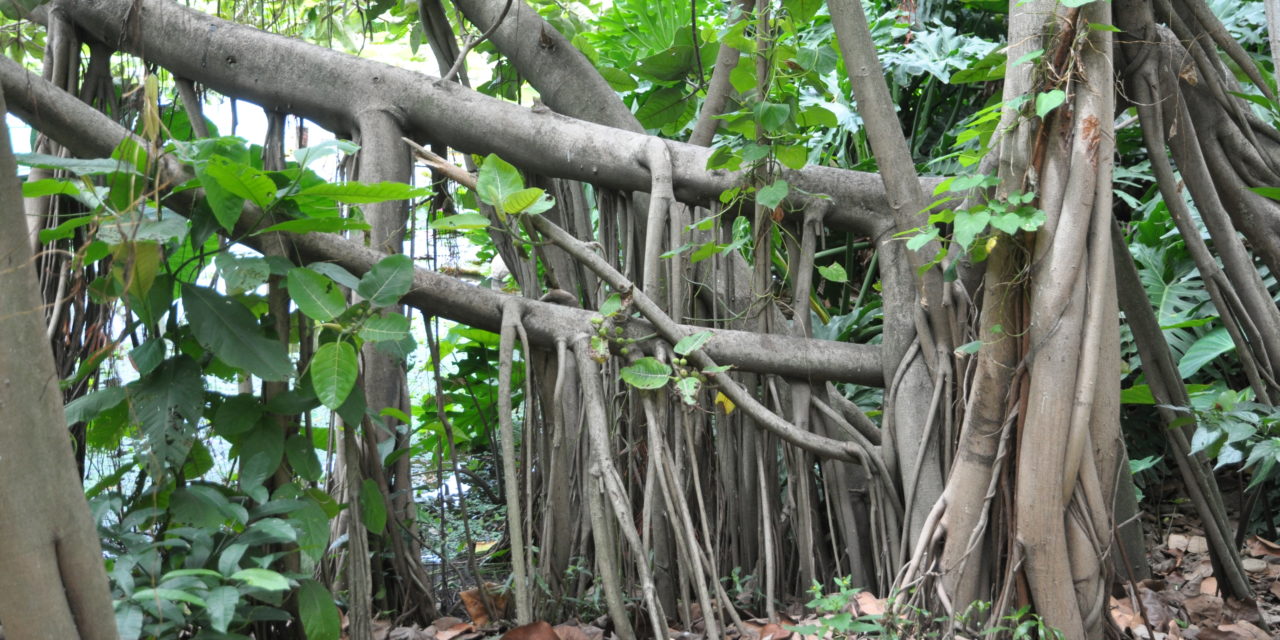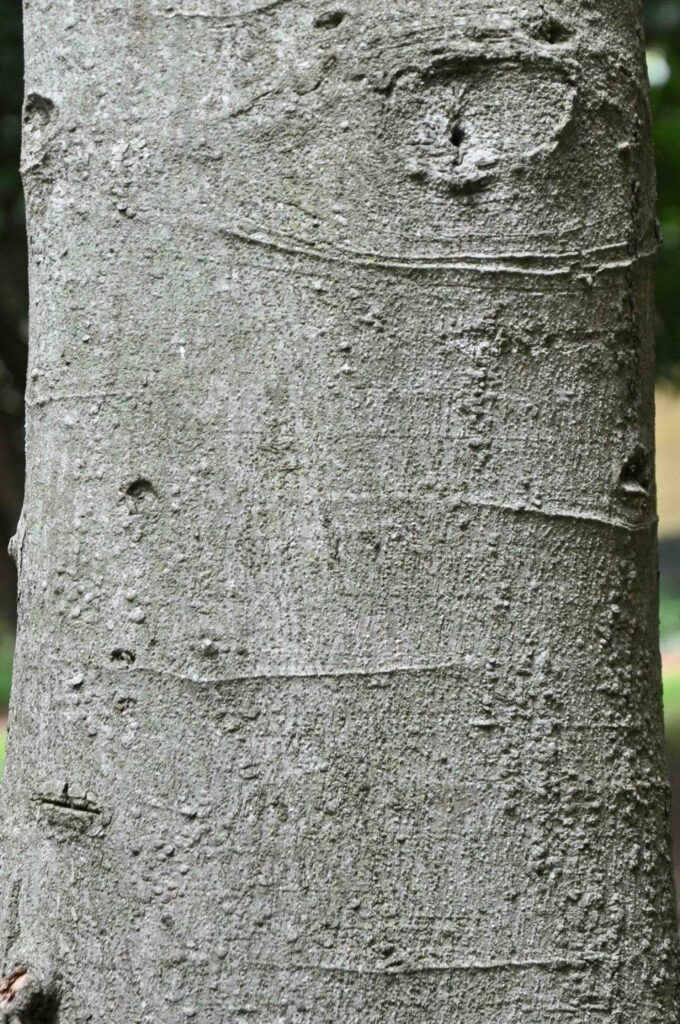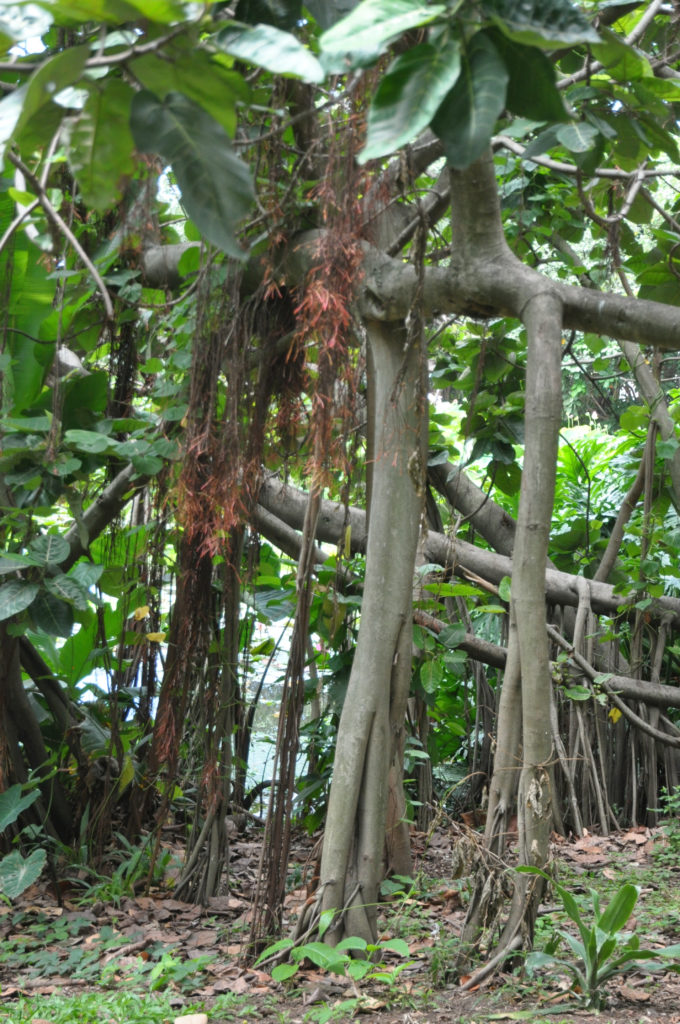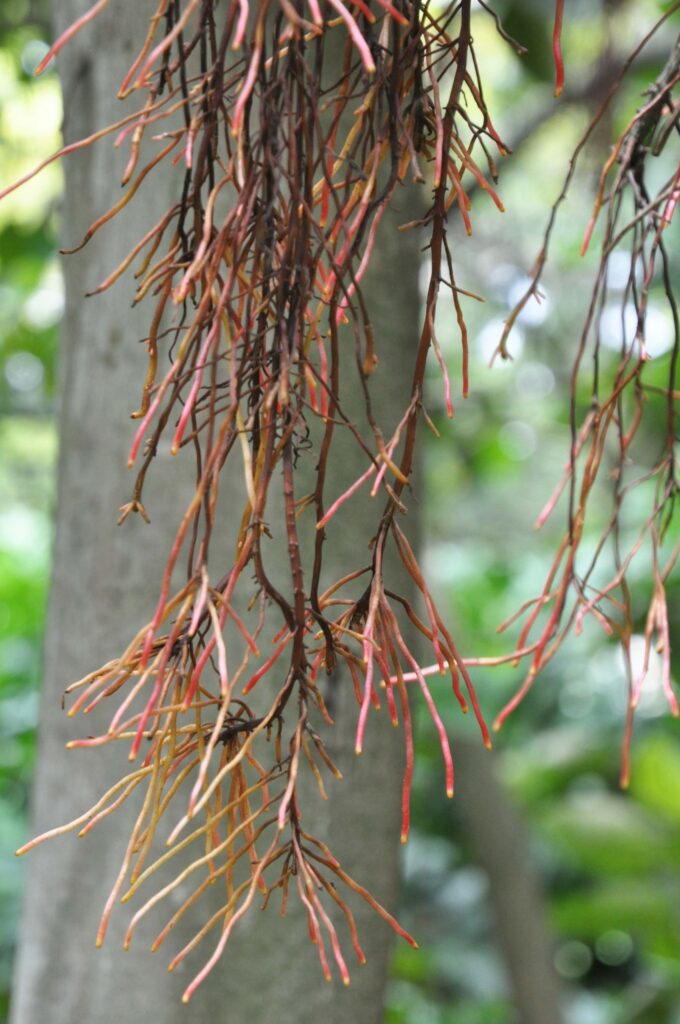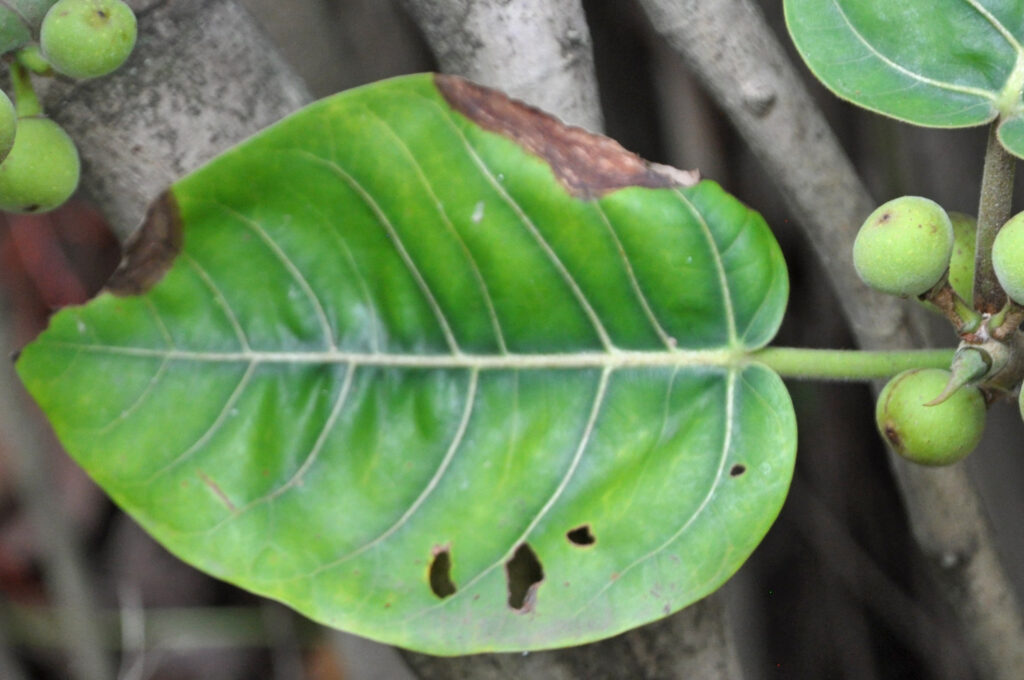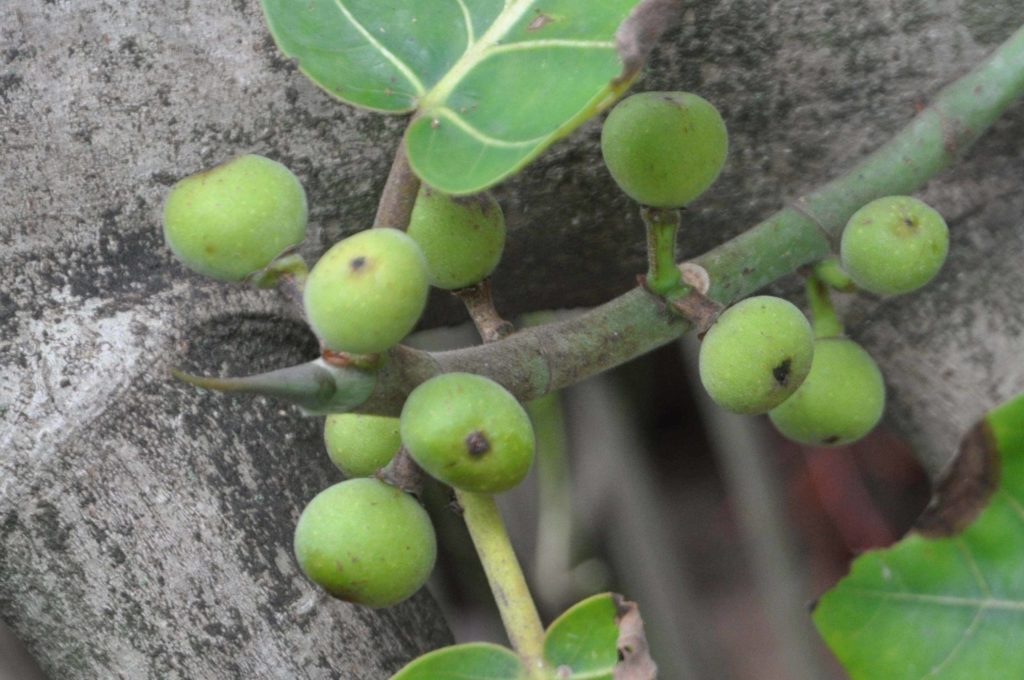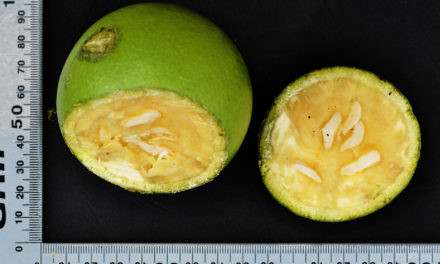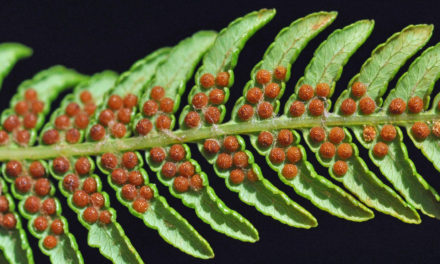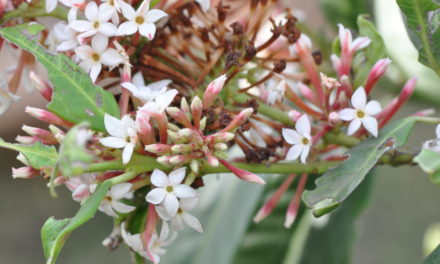General Info – summary
This monoecious, non-strangler fig Tree is up to 21m high and a trunk with a unique horizontally spreading crown with descending prop roots. All damaged parts exude non-toxic milky latex. Large, simple Leaves are distinctly 3-veined at the base. The inflorescence is a syconium with a mutualistic relationship between the fig and the wasp resulting in Flower pollination. The Fruit is a fig with ethylene induced maturing.
Description
Ficus trichopoda
Previous names: Ficus hippopotami, Ficus congoensis, Ficus zuvalensis.
SA Tree No. 54.
Common names: (Aft) Moerasvy. (Eng) Hippo Fig, Swamp Fig, Wild Rubber Tree. (Xitsonga) Alufubu. (isiZulu) Umvubu – the hippo fig – in isiZulu, isiXhosa and seSotho. Umvubu have a similar distribution to the hippo and refers to both the tree and the hippo.
Family: Moraceae (fig or mulberry family). Trees are evergreen and have milky or watery latex present. The simple Leaves are alternate or opposite and 3-veined from near the possibly lobed base. Margins are usually entire, and all leaves have stipules. Plants are monoecious or dioecious and flowers are unisexual. The Perianth of indigenous species contains sepals but no petals. Male flowers have up to 6 stamens. Female flowers are inconspicuous and lack staminodes. The superior or inferior Ovary has 1 locule with 1 ovule and 2 styles are often present. The compound usually fleshy Fruit contains various Seeds. The family has 37 genera and about 1 100 species.
Name derivation: Ficus – Latin for fig. trichopoda – hairy feet – may refer to the thin, down hanging branchlets (photo 197 – under Tree). The genus Ficus has 24+ species in southern Africa.
Conservation: National Status: L C. (Least Concern). Assessment Date: 2005 (C.J. Geldenhuys and J.E. Victor).
Tree
This Tree (intro photo), with a rounded, horizontally spreading Trunk, may reach 12m and occasionally 25m high. It may also be a shrub. In swampy areas, the Stem is often horizontal and about 2m above the ground. Descending from this are aerial Prop Roots (photos 196 & 1976) that develop into impressive pillar roots (intro photo). This is Banyan Growth Form where a fruit tree, has branches that produce roots that grow down into the ground to form extra trunks. This growth form is unique to this fig in South Africa. Initially the Trunk is smooth, pale grey-green to brown (photo 202R). In this photo, the young grey or grey-green Bark is covered with pustules (small, raised blisters or pimple like spots). The bark becomes rougher with age. All damaged parts of the plant exude non-toxic milky latex.
- 202R. 2015/02/09. Durban BG. Photo: David Becking.
- 196. 2015/02/09. Durban BG. Photo: David Becking.
- 197. 2015/02/09. Durban BG. Photo: David Becking.
Leaves
The large, attractive, glossy, alternate, leathery and oblong to ovate (egg-shaped) Leaves are velvety below and large – up to 30 x 23cm. The stiff Blade is a dark shiny green and hairless above. The lower side is blue-green and has some fine hairs mainly along the midrib. There are 6-11 pairs of clearly visible white to bluish green Veins (photo 201RR). In Ficus lutea there are 6-8 yellow side veins and prop roots are absent. A pair of lateral veins occurs at the base. This together with the broad midrib makes the leaf 3-veined from the base. On the lower surfaces, Waxy spots occur in axils of secondary veins or at the base of the leaf midrib. Leaves are not rough and sandpaper-like. Young leaves are bright red. The Apex is broadly tapering and bluntly pointed (photo 201RR). The Base is rounded to square and might be lobed or cordate (heart shaped – photo 201RR). The Petiole (leaf stalk) is thick, up to 6cm long and may be reddish. The shiny Stipules (basal appendages of the petiole) are large – up to 5cm long and even longer on new growth. They envelope terminal buds (photo 201M – under Fruit) and are caducous (an organ or part which is easily detached and shed early). When leaves fall, they leave a leaf scar (partially visible in photo 201M – under Fruit).
- 201RR. 2015/02/09. Durban BG. Photo: David Becking.
Flowers
The tree is monoecious (having both male and female reproductive organs on the same plant). Each Inflorescence (flower head) contains both sexes, but the individual flowers are either male or female. Figs possess an amazingly arranged flower head called a Syconium. Essentially this consists of a Receptacle (is that expanded tip of the flower stalk from which the floral parts develop) whose perimeter substantially increases in size and folds over forming the fig shape. The figs occur in axils of young leaves and on young twigs. The hollow fig ends with a tiny opening called an Ostiole (photo 201M – under Fruit), which is covered with scales making exit for wasps impossible and entrance difficult. Only the female pollinating wasp (specific for each fig species – in this case Elisabethiella bergi breviceps in South Africa) attempts to do so. She usually injures herself in the process.
Around the inner boundary of the hollow fig receptacle, large collections of extremely small flowers are located. The Male Flowers have up to 6 overlapping perianth (the 2 floral envelopes considered together; a collective term for the calyx and corolla) lobes and one or two anthers are present. Here the ovary is absent or vestigial (imperfectly developed, non-functional relic from the past). In the Female Flowers, there are no stamens and usually fewer perianth lobes. The Ovary is free and usually has 2 Styles. The Female wasp enters the fig laden with microscopic pollen. The wasp then “accidently” pollinates those female fig flowers with longish styles. These long styles prevent the wasp from laying eggs in that specific ovary. The wasp targets the flowers with short styles and lays a single egg in each one. This female fig flowers react, producing a gall, which nourishes the developing wasp larvae. These larvae eventually pupate and becomes adults. The robust Male wasps develop first, fertilize the young female wasps and then burrow through the wall of the fig allowing oxygen in. The young Female wasps then, unintentionally, loads pollen from the male flowers. They then escape through the opening created by the young male wasps and make her way to another fig, of the same species, to continue the life cycle. This is an excellent example of a Mutualistic relationship (a beneficial relationship between 2 different species in which both benefit) here between the fig tree and the wasp. The fertilized escaped wasps follow a released new host specific chemical, in order to locate the new receptive fig of the same species.
Fruit
Nearly a week after the wasps have left the figs, with their now fertilized seeds, Ripen. They then develop into an orange to red multiple Fruit. Figs are usually borne singly or in pairs (photo 201M) in leaf axils. The fruit stalk is up to about 1,5cm long (photo 201M) and the mature figs are up to 2,2cm wide. The fruit changes from hairy green and becomes orange or red and mottled with pink – possibly hairless when ripe. This is due to the oxygen induced Ethylene production. Ethylene is a small hydrocarbon gas – odourless and tasteless. This gas is involved in the ripening of the fruit, including causing the fruit to change colour, texture and soften. It is used commercially to ripen fruits like tomatoes, bananas and pears. (Sep-Apr).
- 201M. 2015/02/09. Durban BG. Photo: David Becking.
Distribution & Ecology
This is a protected Tree in the South Africa that occurrs near water – including coastal and forest swamp forests as well as high rainfall areas like riverine forests. Clumps of trees may develop. These trees are located in KwaZulu-Natal North Coast (from about Ballito northwards), and are mainly coastal in Mozambique, Zambia, Malawi, to East central Africa. They also occur in the Ivory Coast in West Africa and in Madagascar. Swamp Figs are eaten by birds e.g., the Natal thrush, and by monkeys. There is a good specimen, with a prehistoric appearance, in the Durban Botanical Gardens. This is the oldest botanical garden in Africa and their trees are very impressive. The gardens were initially established in 1849 before being relocated to the present site.
Ethnobotany
This tree makes good pot-plants and bonsai and is an attractive tree to have indoors. The Foliage is very attractive – more so than other fig leaves. The strong fibred Bark is used to make plaited rope. The Latex makes good birdlime. Propagation is by seeds and truncheons (stem cutting from a selected plant – used to produce genetically identical new plants).
References
Boon, R. 2010. Pooley’s Trees of eastern South Africa. Flora and Fauna Publications Trust, Durban.
Burrows, J.E., Burrows, S.M., Lotter, M.C. & Schmidt, E. 2018. Trees and Shrubs Mozambique. Publishing Print Matters (Pty) Ltd. Noordhoek, Cape Town.
Coates Palgrave, M. 2002. Keith Coates Palgrave Trees of Southern Africa, edn 3. Struik, Cape Town.
Geldenhuys, C.J. & Victor, J.E. 2005. Ficus trichopoda Baker. National Assessment: Red List of South African Plants version 2020.1. Accessed on 2023/06/18.
Lawrence, G. H. M, 1951. Taxonomy of Vascular Plants, The Macmillan Company, New York. Tenth Printing 1965.
Palmer, E. & Pitman, N. 1972. Trees of southern Africa, Balkema, Amsterdam, Cape Town.
van Noort, S. & Rasplus, JY. 2021. Figweb: figs and fig wasps of the world. URL: www.figweb.org. Accessed on 05-08-2021.
van Wyk, B. & van Wyk, P. 1997 Field guide to Trees of Southern Africa, Struik, Cape Town.
http://www.plantzafrica.com/plantefg/ficustrich.htm
http://www.westafricanplants.senckenberg.de/root/index.php?page_id=78&id=727#. Good photos
http://posa.sanbi.org/flora/browse.php?src=SP

